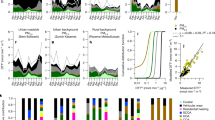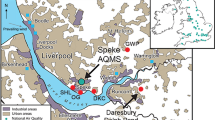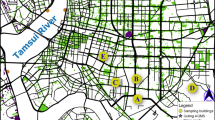Abstract
We examined the effect of proximity to specific mobile, area, and point sources on the residential outdoor concentrations of fine particulate matter PM (PM2.5) and several of its particle components. Integrated (48-h) PM2.5 samples were collected outside non-smoking residences in Elizabeth, NJ, between summer 1999 and spring 2001. Samples were analyzed for PM2.5 mass, organic and elemental carbon (OC and EC, respectively), trace elements, particle-phase polycyclic aromatic hydrocarbons (p-PAHs), and other important particle species. Information about the proximity of the study homes to potential mobile and area sources of OC, EC, p-PAHs, sulfur (S), and selenium (Se) (including urban interstate highways, local roadways, the Newark International Airport, the Elizabeth seaport, and a nearby refinery in Linden, NJ) were retrieved from a database that included detailed emissions, meteorological, and geographical data for the study area. The dependence of residential outdoor concentrations on source proximity and on various meteorological parameters was then examined for each species by multiple linear regression analysis. As expected, the predicted ambient air concentrations of all particle species (except S, Se) decreased with increasing distance from the sources. Although the enhancement in PM2.5 and OC levels outside the study homes closest to primary PM sources was modest (e.g., 1.6 and 2.5 times the background levels 37 m from interstate highways), the elevation of EC and p-PAH concentrations was substantial outside the closest study homes (i.e., about 20 times for p-PAHs 37 m from interstate highways and about 14 times for EC 192 m from the refinery in Linden, NJ). The predicted EC concentrations 192 and 500 m from the oil refinery were 22.8 and 3.0 μgC/m3, compared with an urban background of 1 μgC/m3. Thus, emissions from this source might dramatically affect EC exposure for residents living in its close proximity.
This is a preview of subscription content, access via your institution
Access options
Subscribe to this journal
Receive 6 print issues and online access
$259.00 per year
only $43.17 per issue
Buy this article
- Purchase on Springer Link
- Instant access to full article PDF
Prices may be subject to local taxes which are calculated during checkout





Similar content being viewed by others
References
Celis J., Morales R., Zaror C., Inzunza J., Flocchini R., and Carvacho O. Chemical characterization of the inhalable particulate matter in the city of Chillan, Chile. J Chil Chem Soc 2003: 48 (2): 49–55.
Chuersuwan N., Turpin B.J., and Pietarinen C. Evaluation of time-resolved PM2.5 data in urban/suburban areas of New Jersey. J Air Waste Manag Assoc 2000: 50 (10): 1780–1789.
Chuersuwan N. New Jersey PM2.5: Issues pertaining to the development of effective control strategies. PhD Dissertation, Rutgers University: New Brunswick, NJ, 2001.
Kaiser J. Mounting evidence indicts fine-particle pollution. Science 2005: 308 (5722): 633.
Kwon J., Weisel C.P., Turpin B.J., Zhang J.F., Korn L.R., Morandi M.T., Stock T.H., and Colome S. Source proximity and outdoor-residential VOC concentrations: results from the RIOPA. Environ Sci Technol 2006: 40 (13): 4074–4082.
Lee J.H., Gigliotti C.L., Offenberg J.H., Eisenreich S.J., and Turpin B.J. Sources of polycyclic aromatic hydrocarbons to the Hudson River Airshed. Atmospheric Environment 2004: 38 (35): 5971–5981.
Lee J.H., Yoshida Y., Turpin B.J., Hopke P.K., Poirot R.L., Lioy P.J., and Oxley J.C. Identification of sources contributing to Mid-Atlantic regional aerosol. J Air Waste Manag Assoc 2002: 52 (10): 1186–1205.
Lena T.S., Ochieng V., Carter M., Holguin-Veras J., and Kinney P.L. Elemental carbon and PM2.5 levels in an urban community heavily impacted by truck traffic. Environ Health Perspect 2002: 110 (10): 1009–1015.
Lim H.J., Turpin B.J., Russell L.M., and Bates T.S. Organic and elemental carbon measurements during ACE-Asia suggest a longer atmospheric lifetime for elemental carbon. Environ Sci Technol 2003: 37 (14): 3055–3061.
Liu W., Zhang J., Zhang L., Turpin B., Weisel C., Morandi M., Stock T., Colome S., and Korn L. Estimating contributions of indoor and outdoor sources to indoor carbonyl concentrations in three urban areas of the United States. Atmospheric Environment 2006: 40 (12): 2202–2214.
Marcazzan G.M., Valli G., and Vecchi R. Factors influencing mass concentration and chemical composition of fine aerosols during a PM high pollution episode. Sci Total Environ 2002: 298 (1–3): 65–79.
Meng Q.Y., Turpin B.J., Korn L., Weisel C.P., Morandi M., Colome S., Zhang J.F.J., Stock T., Spektor D., Winer A., Zhang L., Lee J.H., Giovanetti R., Cui W., Kwon J., Alimokhtari S., Shendell D., Jones J., Farrar C., and Maberti S. Influence of ambient (outdoor) sources on residential indoor and personal PM2.5 concentrations: analyses of RIOPA data. J Expo Anal Environ Epidemiol 2005: 15 (1): 17–28.
Meng Q.Y., Turpin B.J., Polidori A., Lee J.H., Weisel C.P., Morandi M., Colome S., Zhang J., Stock T., and Winer A. How does infiltration behavior modify the composition of ambient PM2.5 in indoor spaces? an analysis of RIOPA data. Environ Sci Technol 2007: 41: 7315–7321.
Naumova Y.Y., Offenberg J.H., Eisenreich S.J., Polidori A., Meng Q.Y., Turpin B.J., Weisel C.P., Morandi M.T., Colome S.D., Stock T.H., Winer A.M., Alimokhtari S., Kwon J., Maberti S., Shendell D., Jones J., and Farrar C. Gas/particle distribution of polycyclic aromatic hydrocarbons in coupled outdoor/indoor atmospheres. Atmospheric Environment 2003: 37: 703–719.
Naumova Y.Y., Totten L.A., Eisenreich S.J., Turpin B.J., Colome S.D., Morandi M.T., Weisel C.P., Stock T.H., Winer A.M., Alimokhtari S., Kwon J., Maberti S., Shendell D., and Wall S.J. Polycyclic aromatic hydrocarbons in the indoor and outdoor air of three cities in the U.S.: results from the RIOPA study. Environ Sci Technol 2002: 36: 2552–2559.
Nel A., Xia T., Madler L., and Li N. Toxic potential of materials at the nanolevel. Science 2006: 311 (5761): 622–627.
Netter J., Kutner M.H., Nachtsheim C.J., and Wasserman W. Applied Linear Statistical Models, 4th edn. R.D. Irwin., 1996.
Offenberg J., Naumova Y., Turpin B., Eisenreich S., Morandi M., Stock T., Colome S., Winer A., Spektor D., Zhang J., and Weisel C. Chlordanes in the indoor and outdoor air of three US cities. Environ Sci Technol 2004: 38: 2760–2768.
Polidori A., Arhami M., Sioutas C., Delfino R.J., and Allen R. Indoor/outdoor relationships, trends, and carbonaceous content of fine particulate matter in retirement homes of the Los Angeles basin. J Air Waste Manag Assoc 2007: 57 (3): 366–379.
Polidori A., Turpin B., Meng Q.Y., Lee J.H., Weisel C., Morandi M., Colome S., Stock T., Winer A., Zhang J., Kwon J., Alimokhtari S., Shendell D., Jones J., Farrar C., and Maberti S. Fine organic particulate matter dominates indoor-generated PM2.5 in RIOPA homes. J Expo Sci Environ Epidemiol 2006a: 16 (4): 321–331.
Polidori A., Turpin B.J., Lim H.J., Cabada J.C., Subramanian R., Robinson A., and Pandis S. Local and regional secondary organic aerosol: insights from a year of semi-continuous carbon measurements at Pittsburgh. Aerosol Sci Technol 2006b: 40 (10): 861–872.
Pope C.A., and Dockery D.W. Health effects of fine particulate air pollution: lines that connect. J Air Waste Manag Assoc 2006: 56 (6): 709–742.
Reff A., Turpin B.J., Porcja R.J., Giovennetti R., Cui W., Weisel C.P., Zhang J., Kwon J., Alimokhtari S., Morandi M., Stock T., Maberti S., Colome S., Winer A., Shendell D., Jones J., and Farrar C. Functional group characterization of indoor, outdoor, and personal PM2.5: results from RIOPA. Indoor Air 2005: 15 (1): 53–61.
Roorda-Knape M.C., Janssen N.A.H., De Hartog J.J., Van Vliet P.H.N., Harssema H., and Brunekreef B. Air pollution from traffic in city districts near major motorways. Atmospheric Environment 1998: 32 (11): 1921–1930.
Schauer J.J. Evaluation of elemental carbon as a marker for diesel particulate matter. J Expo Anal Environ Epidemiol 2003: 13 (6): 443–453.
Schauer J.J., Kleeman M.J., Cass G.R., and Simoneit B.R.T. Measurement of emissions from air pollution sources. 2. C-1 through C-30 organic compounds from medium duty diesel trucks. Environ Sci Technol 1999a: 33 (10): 1578–1587.
Schauer J.J., Kleeman M.J., Cass G.R., and Simoneit B.R.T. Measurement of emissions from air pollution sources. 1. C-1 through C-29 organic compounds from meat charbroiling. Environ Sci Technol 1999b: 33 (10): 1566–1577.
Shi J.P., and Harrison R.M. Regression modeling of hourly NOX and NO2 concentrations in urban air in London. Atmospheric Environment 1997: 31: 4081–4094.
USEPA. Air Quality Criteria for Particulate Matter. Research Triangle Park: NC, 2004.
Van Wijnen J.H., and Van der Zee S.C. Traffic-related air pollutants: exposure of road users and populations living near busy roads. Rev Environ Health 1998: 13: 1–25.
Weisel C.P., Zhang J., Turpin B.J., Morandi M.T., Colome S., Stock T.H., Spektor D.M., Korn L., Winer A., Alimokhtari S., Kwon J., Mohan K., Harrington R., Giovanetti R., Cui W., Afshar M., Maberti S., and Shendell D. The relationships of indoor, outdoor and personal air (RIOPA) study: study design, methods, and quality assurance/control results. J Expo Anal Environ Epidemiol 2005: 15: 123–137.
Xia T., Korge P., Weiss J.N., Li N., Venkatesen M.I., Sioutas C., and Nel A. Quinones and aromatic chemical compounds in particulate matter (PM) induce mitochondrial dysfunction: implications for ultrafine particle toxicity. Environ Health Perspect 2004: 112 (14): 1347–1358.
Zhu Y.F., Hinds W.C., Kim S., Shen S., and Sioutas C. Study of ultrafine particles near a major highway with heavy-duty diesel traffic. Atmospheric Environment 2002: 36 (27): 4323–4335.
Acknowledgements
We gratefully acknowledge the hospitality of the RIOPA participants, the hard work of all the students and technicians involved in this study, and Dr. Jim Zhang for his valuable contributions. This research was supported by The Mickey Leland National Urban Air Toxics Research Center (NUATRC) (contract no. 96-01A/P01818769) and by The Health Effects Institute (HEI, contract no. 98-23-3). HEI is jointly funded by the USEPA (EPA: Assistance Agreement R828112) and automotive manufacturers. This data analysis was supported by the USEPA Office of Transportation and Air Quality (contract no. 68-C-04-149). The contents of this article do not necessarily reflect the views of the Mickey Leland NUATRC, HEI, (and policies of) EPA or of motor vehicle, and engine manufacturers. Drs. Weisel and Turpin were supported in part by the National Institute of Environmental Health Center for Excellence (ES05022) and Dr. Turpin was supported in part by the NJ Agricultural Experiment Station.
Author information
Authors and Affiliations
Corresponding author
Ethics declarations
Competing interests
The authors declare no conflict of interest.
Additional information
Supplementary Information accompanies the paper on the Journal of Exposure Science and Environmental Epidemiology website
Supplementary information
Rights and permissions
About this article
Cite this article
Polidori, A., Kwon, J., Turpin, B. et al. Source proximity and residential outdoor concentrations of PM2.5, OC, EC, and PAHs. J Expo Sci Environ Epidemiol 20, 457–468 (2010). https://doi.org/10.1038/jes.2009.39
Received:
Accepted:
Published:
Issue Date:
DOI: https://doi.org/10.1038/jes.2009.39
Keywords
This article is cited by
-
Variability in the fraction of ambient fine particulate matter found indoors and observed heterogeneity in health effect estimates
Journal of Exposure Science & Environmental Epidemiology (2012)



